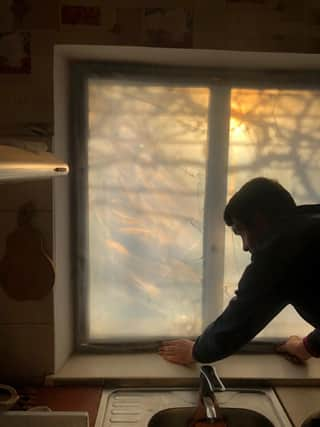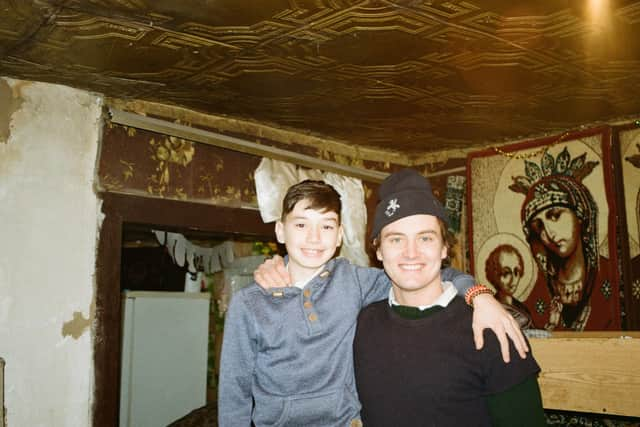The Fife student who has helped replace 10,000 blown-out windows in war-hit Ukraine


When student Louis Hall received a phone call from his friend, Harry Blakiston Houston, last Christmas, asking him to go with him to Ukraine, he didn’t hesitate to agree.
"He told me about an article he’d read about houses in Ukraine which had no windows due to bombing – and which couldn’t be replaced because of a shortage of glass,” he recalls. “He told me ‘I've got an idea. I think we should go to Ukraine and try it’.
"I was like, ‘Great, let's go’.”
Advertisement
Hide AdAdvertisement
Hide Ad

Days later, the pair rented a car in the Ukrainian capital, Kyiv and visited a local hardware store for supplies before driving east, to recently-liberated Izyum.
Mr Blakiston Houston, a PhD student in the engineering department at the University of Cambridge, had devised a cheap replacement window design, using layers of polyethylene and PVC piping. Having tested it in his lab, he was confident the design was shatterproof and provided insulation. Best of all, they cost around £12 to make.
"Izyum was completely devastated, it was even worse than I had imagined,” says Mr Hall, a creative writing student at Oxford University, from Oakley, near Dunfermline.
Elena, a woman in Izyum who they had made contact with ahead of their trip, took them to a friend’s home which had no windows since the glass had been shattered by Russian missiles. At the time of their visit, temperatures in eastern Ukraine had plummeted to minus 17 Celsius.
"We didn't know entirely if the design was going to work – we knew it worked in a lab, but that is different,” says Mr Hall. “We took a measurement of the temperature inside the room before we put in the window and it was two degrees Celsius. Then we took a temperature check the next day, and it was 17 degrees Celsius. We felt pretty relieved that there was evidence and proof of the fact that the design worked.
“That was our first window.”
Now the charity, Insulate Ukraine, has reached the milestone of 10,000 successful window installations and has facilitated the return of almost 3,000 individuals to their homes.
It employs 32 Ukrainians to install the windows in five teams across Ukraine – but plans to rapidly expand to extend its services to residents living on the front line before winter sets in.
"The worst of the winter is basically the end of January,” says Mr Hall. “We want to get as many as possible done before then.”
Advertisement
Hide AdAdvertisement
Hide AdUntil Insulate Ukraine’s work began, most residents had been covering their blown-out windows with old carpets, or MDF boards and sandbags.
“The theory was that four layers of polyethylene sheeting would provide insulation for the trapped air and it would allow for natural light to come through,” says Mr Hall. “Obviously it is opaque, but it still lets through natural light and it it is very cheap to make and very light, so easily transportable.”
Other types of replacement window used in some areas were made from materials including wood and polystyrene, which are more expensive to produce, transport, and install. Insulate Ukraine estimates that materials for 4,000 of its windows can be fitted into a single truck, compared to around 30 equivalent windows made from glass.
A chance meeting with an English teacher in a butcher’s shop allowed them to create a network of contacts in Izyum who needed their help.
"She realised we didn’t speak the language and she decided to help us,” Mr Hall says. “We got her on board to handle all the people that needed our help. So she created an enormous database, using WhatsApp.
"In the next few weeks, Harry and I – and another friend, Alexei, who joined us from Kyiv - were just putting in windows and making windows every day.”
Since then, the charity has fundraised enough to set up more than 30 teams of local people – many of whom were unable to work in their usual industries because of the war – who are paid to fit windows in their local area.
Mr Hall recalls one woman who had been living in her bathroom – as it was the only space in her house without blown-out windows.
Advertisement
Hide AdAdvertisement
Hide Ad"The next day when we came back after installing the windows, she was in floods of tears because for the first time, she was walking around with a jumper and jeans on instead of living in a sleeping bag in her bathroom – and she just started to rebuild her home. I think what has been the most powerful thing to witness is the ability for people to start living again - really not just surviving, but living – and to be able to start actually feeling comfortable in their own home.
"For each of the 10,000 windows that we’ve put in, we’ve made a building go from unliveable to somewhere that's actually liveable or could be rebuilt.”
He adds: “Many people who who remain in the liberated areas are elderly, people who don't want to leave their home - they've got nothing else. Some are disabled and some are people who can't afford to leave, so many are people without much ability to keep themselves warm. The biggest difference is for people to have a quality of life that allows them to be warm and have natural light.”
Comments
Want to join the conversation? Please or to comment on this article.
